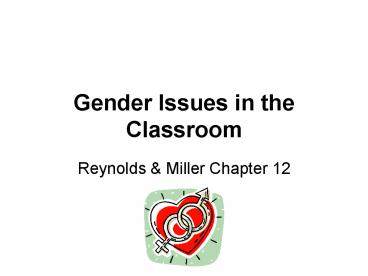Gender Issues in the Classroom - PowerPoint PPT Presentation
1 / 9
Title:
Gender Issues in the Classroom
Description:
possibilities for girls and boys in school? ... Boys are more at risk for missed ... Equip this center with boys/girls clothes, anatomically correct dolls ... – PowerPoint PPT presentation
Number of Views:7860
Avg rating:5.0/5.0
Title: Gender Issues in the Classroom
1
Gender Issues in the Classroom
- Reynolds Miller Chapter 12
2
Gendered socialization ?how male and female
students Receive and interpret different
messages about appropriate Classroom behaviors
- Central Questions
- To what extent do schools and teachers
expectations of males and - females influence their development,
behavior, and academic success? - 2. How do classroom interactions and school
curriculum socially construct - what it means to be female and male and in
what way does it limit - possibilities for girls and boys in school?
Let answer these questions first by a)
describing the developmental structures, b)
chemical differences, c) hormonal differences, d)
functional differences, and e) differences in
processing emotions.
a)
3
b)
Intra- Gender V A R I A B I L I T Y
c)
4
d)
5
e)
Defining Gender Issues Equity in Education
Practice or policy that limit learning
opportunities for females and males
2 types of sexual harassment quid pro
quo Environment harassment
Title XI 1972
Title VII 1964
OCR Title IX
UN 1995
Gender Equitable Learning Environments Caring,
safe, routines, curriculum experiences
Gender Issues in Education
6
Gender Issues Facing Educators
Gender Issues Facing Educators
Gender Issues Facing Educators
- Hidden, Formal and Null
- Curriculum
- Teacher behaviors tacit
- messages
- Due to unconscious or
- unexamined behaviors
- Class, give examples at the
- elementary, middle, high schools
- and college
- Gender Issues in the Classroom
- Gaps
- Risks for girls
- Drop out rates
- Risks for boys
- Sports and physical activities
- Course taking
- and testing
- Classroom Climate
- Teacher questions and student responses (type and
- Student voice or air time sanctions)
- Teacher attention to student appearance
- Amount of wait time
- Teacher student coaching
- Teacher assigned jobs
7
- Gender Issues in Early Childhood Environments
- Girls receive more praise
- Boys are more socialized
- Girls needs are more overlooked than boys
- Girls come to kindergarten with better fine motor
skills?they should be - exposed to activities with large motor skills
- The needs of boys were met during instructional
class time - Segregated play do not meet both sexes needs
- Segregated play is encouraged by media
advertising - Gender and Identity in Primary Grades
- Bad boys silent girls?sweeping generalizations
- 30 months gender labels
- By preschool internalized gender roles
- Teacher interactions reinforce internalized norms
- Therefore, teachers should empower these children
to - new possibilities
8
- Gender Equity and early Childhood Pedagogy and
Curriculum - Peer discovery learning center
- Provide learning variety of experiences to both
girls and boys - Rename centers from playhouse etc. to drama
center - Avoid action figures glamour dolls
- Participate in creative role playing
- Equip this center with boys/girls clothes,
anatomically correct dolls - Gender segregation happens without teacher
knowledge detrimental - With teacher knowledge enlightening
- Gender Equity in the Middle Grades
- Adolescence difficult period for girls?this
stem from disconnections - Women often silence themselves rather than cause
conflicts or risk - isolation
- Girls at this stage begin to question
themselves?struggle to keep - connected with friends and at the same time see
themselves as part - of a larger social environment womanhood
9
- Body image and Secondary School Student
- Advertisement, thinness, dieting
- Distorted perceptions
- Obesity, anorexia and bulimia?eating disorders
8 million - Glial cells
- Sexual harassment and Secondary School Student
- unwanted and unwelcome sexual behavior that
interferes with life - 83 of girls and 79 of boys have reported sexual
harassment ? - boys harassment have increased in the last 10
years - Mostly it occurs under the nose of the teachers
- Five Phases of McIntosh Curriculum
- Interdisciplinary way of teaching the subject
areas - Phase 1. Womanless history?minorities do not
matter - Phase 2. Women in history?womens history early
1970 - Phase 3. Women as a problem?barrier faced and
discrimination - Phase 4. Women as history?real work in the life
- Phase 5. History redefined or reconstructed to
include all































